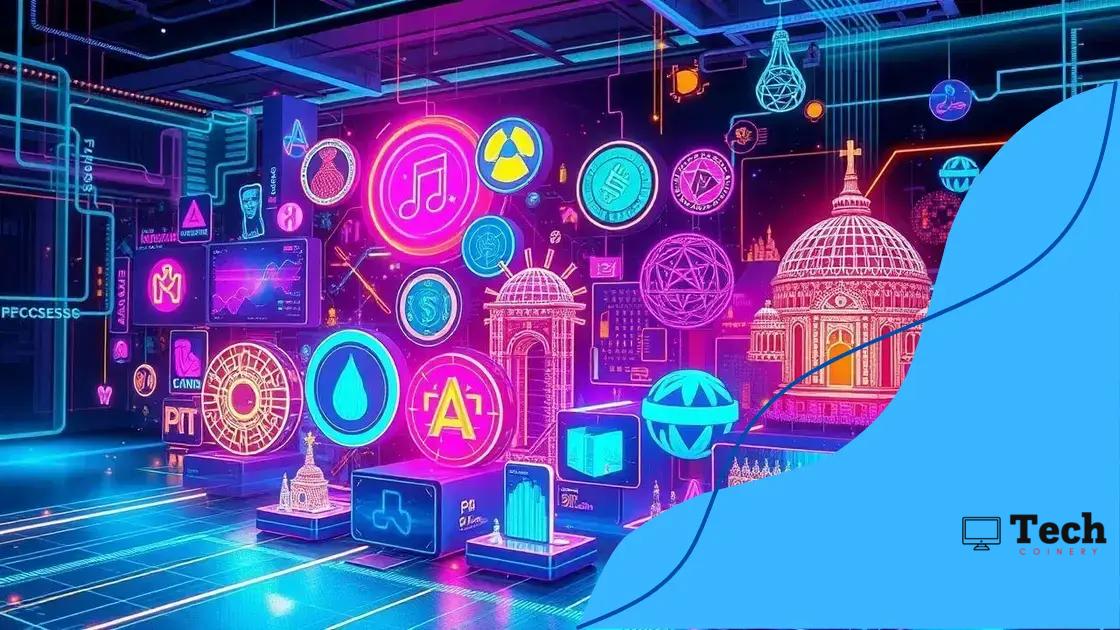Understanding NFTs: Beyond Digital Art

Understanding NFTs involves recognizing their role as unique digital assets that revolutionize ownership and engagement across various industries, including art, gaming, and real estate.
Understanding NFTs is more than just appreciating digital art; it’s about unlocking new forms of ownership and engagement. Have you thought about how these tokens could change various sectors?
What are NFTs and how do they work?
NFTs, or non-fungible tokens, are unique digital assets that represent ownership of a specific item, artwork, or piece of content on the blockchain. Unlike cryptocurrencies such as Bitcoin, which are identical and can be exchanged freely, each NFT has distinct properties that make it one-of-a-kind. This uniqueness is what gives NFTs their value.
The functioning of NFTs is anchored in blockchain technology, a decentralized platform that ensures security and transparency. When someone purchases an NFT, the transaction is recorded on the blockchain, providing a permanent and unchangeable record of ownership.
How NFTs Are Created
NFTs are typically created using a process called minting. This involves uploading a digital file onto a blockchain and creating a token that verifies its authenticity. Once minted, the NFT can be sold or traded on various platforms.
- Minting allows creators to monetize their digital art or content.
- Platforms like OpenSea and Rarible facilitate the buying and selling of NFTs.
- Creators set their own prices, making it accessible for all.
This process makes it possible for artists to receive royalties every time their work is resold. Additionally, NFTs can encompass a wide range of digital items, including music, videos, virtual real estate, and even tweets.
The Role of Smart Contracts
Another vital component of NFTs is the use of smart contracts. These are self-executing contracts with the terms of the agreement directly written into lines of code. Smart contracts automate transactions, ensuring that artists receive their profits efficiently. This innovative technology adds another layer of security to the NFT landscape.
With NFTs, the potential for unique ownership experiences is vast. As technology evolves, we may see more creative uses of NFTs across various industries. They could redefine art ownership, change how we collect digital content, and even transform interactions in the gaming world.
The rise of NFTs beyond digital art
The rise of NFTs has transcended the world of digital art, expanding into various sectors that leverage their unique properties. As these tokens gain popularity, industries are beginning to realize their potential beyond mere collectibles.
One significant area where NFTs are making an impact is in the music industry. Artists can now tokenize their music, allowing fans to own a part of songs or albums. This approach provides musicians with new revenue streams and deeper connections with their audiences.
Applications in Various Industries
NFTs are also making waves in gaming. Players can own virtual assets, such as skins or characters, as NFTs. This ownership allows them to buy, sell, and trade these assets freely, creating a dynamic economy within games.
- Musicians can sell exclusive concert tickets as NFTs.
- Video game developers offer players unique in-game items.
- NFTs are used for virtual real estate, with metaverse platforms gaining traction.
Sports is another sector where NFTs are flourishing. Teams and leagues are creating digital collectibles for fans, such as trading cards or highlight reels. These collectibles not only serve as memorabilia but can also offer additional perks, like access to special events.
The Future of NFTs
As more industries explore the possibilities of NFTs, their use cases continue to grow. Brands are integrating NFTs into their marketing strategies, providing consumers with exclusive experiences. This trend showcases how NFTs can transform traditional business models and enhance consumer engagement.
With ongoing advancements in technology, we can expect innovative applications of NFTs to emerge, broadening their influence across different fields. The future aims to create a more participatory and interactive environment, where ownership and community intertwine.
Use cases of NFTs in different industries

The use cases of NFTs have expanded into various industries, showcasing their versatility and innovative potential. From art to gaming, businesses are discovering how these tokens can enhance their offerings.
In the art world, artists can tokenize their work, allowing them to sell unique pieces directly to collectors. This process eliminates middlemen, ensuring that artists receive fair compensation for their creations.
NFTs in Gaming
In gaming, NFTs have transformed the way players interact with virtual items. Instead of merely renting items, players can now own, sell, and trade various assets, such as characters and skins. This ownership creates a sense of investment and belonging within the game environment.
- Players can build their own unique identities by customizing their characters with NFT skins.
- Game developers can create limited edition items that drive demand and increase player engagement.
- NFTs allow for decentralized gaming economies, where players can earn real money through gameplay.
Similarly, the sports industry has embraced NFTs to offer fans collectible experiences. Teams and athletes create digital trading cards that capture significant moments in sports history. These collectibles can be bought or sold, often increasing in value as time goes on.
Application in Fashion
The fashion industry is also jumping on the NFT bandwagon. Designers can release limited edition items as NFTs, providing exclusive access to their collections. This strategy not only boosts sales but also fosters a sense of exclusivity among consumers.
Moreover, NFTs can authenticate luxury goods, ensuring buyers that their purchased items are genuine. This application is particularly valuable in combating counterfeit issues that plague the fashion market.
As we see, the potential for NFTs is vast and varied. Each industry is finding unique ways to leverage this technology, increasing engagement and creating new avenues for revenue. It will be interesting to see how these trends evolve and further shape the digital landscape.
Challenges and criticisms of NFTs
While NFTs have gained significant popularity, they are not without challenges and criticisms. Many people have raised concerns about various aspects of this emerging technology.
One major issue is the environmental impact of NFTs. Most NFTs are built on blockchains that use a proof-of-work system, which requires massive amounts of energy. This high energy consumption has drawn criticism from environmentalists who argue that it contributes to climate change.
Market Volatility
Another challenge is the volatility of the NFT market. Prices for NFTs can fluctuate dramatically, making it a risky investment for buyers. Many have experienced significant financial losses, contributing to skepticism about the long-term sustainability of the NFT market.
- Prices can increase rapidly, followed by abrupt declines.
- New trends and fads can drive unpredictable market behavior.
- Not all NFTs gain value; many end up losing their appeal.
Additionally, there are concerns about fraud and copyright infringement. Some individuals have found their work tokenized without permission, leading to disputes over ownership. This lack of regulation in the NFT space can make it challenging for creators to protect their rights.
Accessibility Issues
Accessibility is another significant concern. The technical knowledge required to purchase and store NFTs can be a barrier for many. Users need to understand blockchain technology, wallets, and how to navigate various platforms, which can deter potential buyers.
Furthermore, the cost of entry can be prohibitively high for some individuals, limiting who can participate in this market. As a result, NFTs may only cater to a wealthy demographic, raising questions about inclusivity in this new digital space.
These challenges highlight the need for ongoing discussions and developments in the NFT ecosystem. Addressing these criticisms will be crucial if NFTs are to be more widely adopted and integrated into various sectors.
The future of NFTs and their implications
The future of NFTs holds exciting possibilities that could reshape various industries. As technology advances, we can expect greater innovations and broader applications for these digital assets.
One prominent trend is the increasing integration of NFTs in mainstream media. Major brands are exploring ways to incorporate NFTs into their marketing strategies, allowing them to create unique experiences for consumers. This integration will likely bridge the gap between physical products and digital ownership.
Expansion into New Markets
Beyond art and gaming, NFTs are poised to enter new markets like education and real estate. In education, certificates and diplomas can be issued as NFTs, making it easier to verify credentials. This change could streamline hiring processes by ensuring authenticity.
- NFTs can represent ownership of real estate properties in digital form.
- Students can have verifiable records of their achievements.
- In gaming, expansion will continue, with developers creating immersive worlds reliant on NFT assets.
The implications of NFTs in real estate are particularly intriguing. The capabilities to tokenize properties could make buying and selling homes more efficient. Fractional ownership could allow more people to invest in real estate while lowering barriers to entry.
Community and Social Impact
Moreover, NFTs have the potential to transform community engagement. Artists and creators can establish decentralized platforms where they share profits with their supporters. This model encourages a stronger connection between creators and their audience.
As legal frameworks evolve, the regulation of NFTs will likely become clearer. Ensuring transparency and fairness is essential for their long-term success. Governments may establish guidelines to protect buyers and creators, addressing concerns surrounding copyright and authenticity.
The future of NFTs presents exciting opportunities, but it also requires careful consideration of ethical and practical implications. As we navigate this developing landscape, staying informed will help everyone understand how NFTs may affect their lives.
In conclusion, NFTs are reshaping various industries and offering exciting opportunities for artists, gamers, and collectors. While they hold great potential for innovation, challenges like environmental impact and market volatility must be addressed. As technology evolves, understanding the implications of NFTs will be crucial. Engaging with this new digital landscape allows us to explore novel art forms and economic models that change how we perceive ownership and value.
\n\n
\n
FAQ – Frequently Asked Questions about NFTs
What are NFTs?
NFTs, or non-fungible tokens, are unique digital assets representing ownership of specific items or content on a blockchain.
How do NFTs impact artists?
NFTs allow artists to sell their work directly to collectors, eliminating middlemen and providing new revenue streams.
What are the environmental concerns related to NFTs?
Many NFTs are minted on energy-intensive blockchains, raising issues about their environmental impact.
How can NFTs be utilized in real estate?
NFTs can represent ownership of properties, making buying and selling easier and enabling fractional ownership.






